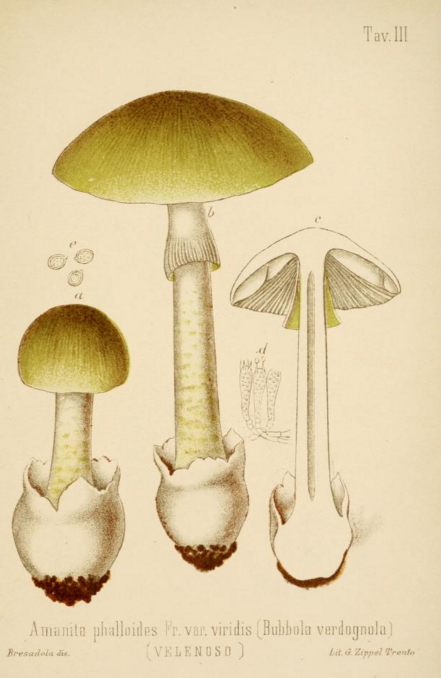Summary: Gold cap mushroom botanical illustrations give distribution ranges and physical appearances of starchy-smelling, starchy-tasting hallucinogenic fungi.
Gold cap mushroom botanical illustrations and images allow appreciation of distribution ranges, life cycles and physical appearances for ancient native hallucinogenic fungi from southeastern North America through Caribbean, Central and South America.
Gold cap mushrooms bear the additional common names gold top, golden cap and golden top because of above-ground surfaces yellowed and yellowing to brown and red-brown. They carry the scientific name Psilocybe cubensis (from the Greek ψῑλός [psīlós, "thin"] κύβη [kubē, "head"]) and the Latin cubensis ("from Cuba") for the Cuba-collected specimen. The Psilocybe genus within the puffball-shaped Hymenogastraceae (from the Greek ὑμήν [humén, "membrane"] and γαστήρ [gastér, "belly"]) family always displays bald, short caps and long stems.
Alabama, Florida, Georgia, Louisiana, Mississippi, North Carolina, South Carolina, Tennessee, Texas and Virginia experience the little brown mushrooms every early to ending autumn, September through November.
Argentina, Belize, Bolivia, Columbia, Costa Rica, Cuba, Dominican Republic, Ecuador, El Salvador, Guatemala, Honduras, Jamaica, Mexico, Peru, Puerto Rico, Trinidad and Venezuela likewise furnish gold caps.
Gold caps, grouped scientifically in 1906 by Franklin Sumner Earle (Sep. 4, 1856-Jan. 31, 1929) and Rolf Singer (June 23, 1906-Jan. 18, 1994), grow from spores. The 0.0000055- to 0.000016-inch- (0.14- to 0.42-micron-) long, 0.000014- to 0.000051-inch- (0.37- to 1.3-micron-) thick, wind-dispersed gold cap mushroom spores have elliptical shapes and purple-brown colors. They increase to maximum above-ground fruiting- and below-ground vegetative-bodied dimensions within two months of winds impelling them from parental gill cells throughout their grassland habitat niches.
Gold cap mushroom botanical illustrations and images juggle spore journeys at subtropical to tropical temperatures of 70 to 80 degrees Fahrenheit (21.11 to 26.66 degrees Celsius).
Gold cap mushroom spores, germinatable year-round, know their fastest, healthiest, most natural growth in humid grassland habitat niches with dung from large grazers such as cows.
The gold cap pileus (from the Greek πῖλος [pîlos, "felt"]) looks like a bell-shaped, convex (outward-curved) cap with a 0.79- to 3.15-inch (2 to 8-centimeter) diameter. Its color-changing, contact-, moisture-, temperature-sensitive surface matures into an umbrella-like shape within one pointed, tiny umbo (from the Latin umbō, "protrusion") or more at the center. A noticeable ring nudges the cinnamon, gold-brown, red-cinnamon cap, at its gilled, spore-producing underside, from the upper long-stalked, thin-stemmed stipe (from the Greek στέφω [stéphō, "encircle"]).
Gold cap mushroom botanical illustrations and images offer 1.58- to 5.91-inch- (4- to 15-centimeter-) long, 0.19- to 5.91-inch- (0.5- to 15-centimeter-) thick, stringy, tough, white stipes.
White tufts sometimes protect stem bases from the underground network-like mycelia (from the Greek μύκης [múkēs, "mushroom"]) of thread-like hyphae (from the Greek ὑφή [huphé, "web"]).
All gold cap mushroom mycelia, pilei and stipes queue up blue-black pitting from contact and injury, opaqueness from dryness, translucence from overwatering and yellowing with age. Darker blue-black bruising reveals higher retentions of baeocystin, norbaeocystin, psilocin and psilocybe compounds, whose hallucinogenic properties result in government restrictions on gold cap cultivation and use. Subtropical and tropical grasslands that support cows and other grazing, large herbivores (plant-eaters) sustain gold cap mushrooms and their spread into northern Australia and southern Asia.
Gold cap mushroom botanical illustrations and images teem with all the portrayable facts about gold cap mushrooms, American hallucnogenic fungus with starchy scents, tastes and textures.
 |
| native and introduced range map for gold cap mushroom (Psilocybe cubensis): Photohound, Public Domain, via Wikimedia Commons |
Acknowledgment
My special thanks to talented artists and photographers/concerned organizations who make their fine images available on the internet.
Image credits:
Image credits:
first description's images of gold cap mushroom (Psilocybe cubensis), under synonym Stropharia cubensis (upper), with another new species, Stropharia floccosa (lower); F.S. Earle, "Algunos Hongos Cubanos," pages 225-242, Primer informe anual de la Estación Central Agronómica de Cuba, 1o. de abril, 1904-30 de junio, 1905 (1906), Lámina XL: Public Domain in the United States, Google-digitized, via HathiTrust @ https://hdl.handle.net/2027/hvd.32044106392509?urlappend=%3Bseq=523;
Public Domain in the United States, Google-digitized, via HathiTrust @ https://babel.hathitrust.org/cgi/pt?id=hvd.32044106392509&seq=523&view=1up
Public Domain in the United States, Google-digitized, via HathiTrust @ https://babel.hathitrust.org/cgi/pt?id=hvd.32044106392509&seq=523&view=1up
native and introduced range map for gold cap mushroom (Psilocybe cubensis): Photohound, Public Domain, via Wikimedia Commons @ https://commons.wikimedia.org/wiki/File:Psilocybe-cubensis-range-map.png
For further information:
For further information:
Earle, F.S. (Franklin Sumner). 1906. "Algunos Hongos Cubanos: Stropharia Cubensis sp. nov. (Fig. 1 Lam. 40)." Primer Informe Anual de la Estación Central Agronómica de Cuba. 1o de Abril, 1904-30 de Junio, 1905. 1: 225-242. Habana, Cuba: Papeleria "la Universal" de Ruiz y Hermano, el 1o de Junio de 1906.
Available via HathiTrust @ https://hdl.handle.net/2027/hvd.32044106392509?urlappend=%3Bseq=252
Available via HathiTrust @ https://hdl.handle.net/2027/hvd.32044106392509?urlappend=%3Bseq=252
Stamets, Paul. 1996. Psilocybin Mushrooms of the World: An Identification Guide. Berkeley CA: Ten Speed Press.








